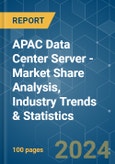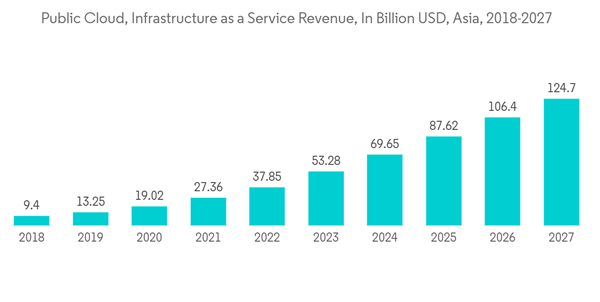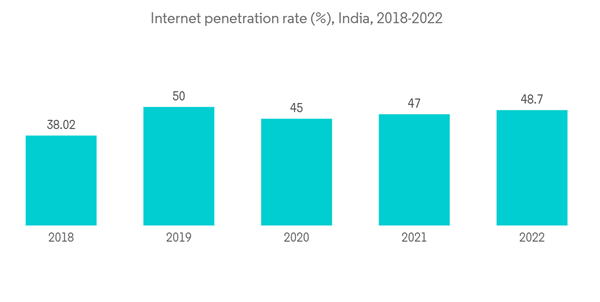The Asia-Pacific data center server market reached a value of USD 33.9 billion in the previous year, and it is further projected to register a CAGR of 14.3% during the forecast period. The increasing demand for cloud computing among small and medium-sized enterprises (SMEs), government regulations for local data security, and growing investment by domestic players are some of the major factors driving the demand for data centers in the region.
In August 2023, Dell Inc. is transitioning its servers with Next-generation Dell PowerEdge Servers from OSA to ESA with PowerEdge R760 powered by 4th generation Intel Xeon Processors.
In January 2023, Cisco announced the launch of the 7th generation of UCS C-Series and X-Series servers, powered by 4th generation Intel Xeon scalable processors. With support for the latest Intel processors, Cisco has launched two new blades for the X-Series: the Cisco UCS X210c M7 Compute Node and the Cisco UCS X410c M7 Compute Node.
This product will be delivered within 2 business days.
Key Highlights
- The upcoming IT load capacity of the Asia-Pacific data center construction market is expected to reach 23K MW by 2029.
- The region's construction of raised floor area is expected to increase 74.5 million sq. ft by 2029.
- The region's total number of racks to be installed is expected to reach 4.2 million units by 2029. India is expected to house the maximum number of racks by 2029.
- There are close to 160 submarine cable systems connecting the Asia-Pacific, and many are under construction. One such submarine cable that is estimated to start service in 2024 is Southeast Asia-Japan Cable 2 (SJC2), which stretches over 10,500 Kilometers with a landing point in China, Taiwan, Japan, South Korea, Thailand, and Vietnam.
APAC Data Center Server Market Trends
IT & Telecommunication Segment Holds the Major Share.
- The increasing adoption of cloud-based services is driving the expansion of hyperscale colocation services in the region, resulting in increased demand for space in data centers and, consequently, the need for more servers within data centers.
- The demand for cloud services is promising in Vietnam, Thailand, and other Southeast Asian countries. Thailand will adopt hybrid cloud services rapidly over the next five years, with 67% of the respondents in Thailand having agreed upon the adoption plan. The country's leading cloud customers include those in the digital media, finance, retail, and manufacturing sectors. In Vietnam, the rollout of 5G networks is expected to boost the region's digital economy and lead to increased demand for high-bandwidth network infrastructure. For example, Amazon Web Services (AWS) announced an AWS outpost in Vietnam in November 2021.
- In Australia, currently, about 10-15% of data is created and processed outside a centralized data center or cloud, but the number is expected to cross 60-70% by 2025, a global trend that is also reflected in Australia. The COVID-19 crisis further highlighted that Australia has a great need for digital infrastructure to improve connectivity in remote and rural areas. Thus, edge data centers are becoming more viable options for Australian vendors, especially startups. Overall, the market is expected to showcase a major growth rate during the forecast period.
- The Chinese cloud market is expected to grow from USD 30 billion in 2021 to USD 90 billion by 2025 due to the rising demand for cloud computing services. Cloud computing services are delivered to the users in the form of Software-as-a-Service (SaaS), Platform-as-a-Service (PaaS), and Infrastructure-as-a-Service (IaaS).
- Developments such as increasing adoption of cloud services, expansion of 5G Networks, and the ongoing demand for online payments are, in turn, expected to boost the demand for the data center market from the IT and telecom segment, leading to the significant need for the servers during the forecast period.
India is Expected to Have Significant Market Share in The Coming Years
- India is among the major players in the data center sector in the APAC region. The mobile data speed in India is expected to increase from 20.10 Mbps in 2022 to 38.30 Mbps by 2029, registering a CAGR of 8.9%. The arrival of Jio Telecom in the Indian Internet market offered users increased data speeds and low latency. This increased data consumption by users was owing to streaming online content, playing high-quality graphic online games, teleconsultation, and social media video conferencing apps.
- A majority of the current data centers are being built in Mumbai, Chennai, and Hyderabad. The Central and State governments came up with draft data center policies and incentives. Some states like Uttar Pradesh and Telangana have rolled out the policies already. As resources like power and water have become even more scarce in India, market players will strive to make cleaner and greener data centers than ever before. The cooling and supporting backup infra components will evolve into more efficient and cleaner options.
- In terms of policy, the Government of India and various state governments are revising their data center policies to support the infrastructural growth of data centers in India through tax subsidies. Under a national policy framework for data centers, the IT ministry intends to provide up to INR 15,000 crore ( USD 1,812 million) as incentives. The government plans to invest up to INR 3 lakh crore (USD 0.036 Trillion) in the data center ecosystem over the next five years, as per the policy.
- The spread of the Internet and smartphones has progressed rapidly in India in recent years. The number of internet connections in 2021 has increased significantly to 830 million through the Digital India program. About 55% of all Internet connections were in urban areas, and 97% were wireless. The smartphone base is also growing significantly and is expected to reach 1 billion by 2026. Such instances in the country are expected to drive the demand for data center server manufacturers in the coming years.
APAC Data Center Server Industry Overview
The upcoming DC construction projects in the region will increase the demand for data center servers in the coming years. The Asia-Pacific data center server market is moderately consolidated, with a few major players, such as Dell Inc., Hewlett Packard Enterprise, Fujitsu, and Lenovo Group Limited. These major players, with a prominent market share, focus on expanding their regional customer base.In August 2023, Dell Inc. is transitioning its servers with Next-generation Dell PowerEdge Servers from OSA to ESA with PowerEdge R760 powered by 4th generation Intel Xeon Processors.
In January 2023, Cisco announced the launch of the 7th generation of UCS C-Series and X-Series servers, powered by 4th generation Intel Xeon scalable processors. With support for the latest Intel processors, Cisco has launched two new blades for the X-Series: the Cisco UCS X210c M7 Compute Node and the Cisco UCS X410c M7 Compute Node.
Additional Benefits:
- The market estimate (ME) sheet in Excel format
- 3 months of analyst support
This product will be delivered within 2 business days.
Table of Contents
1 INTRODUCTION
4 Market Dynamics
5 MARKET SEGMENTATION
6 COMPETITIVE LANDSCAPE
6.1.3 Lenovo Group Limited
6.1.8 Inspur Group
Methodology

LOADING...










